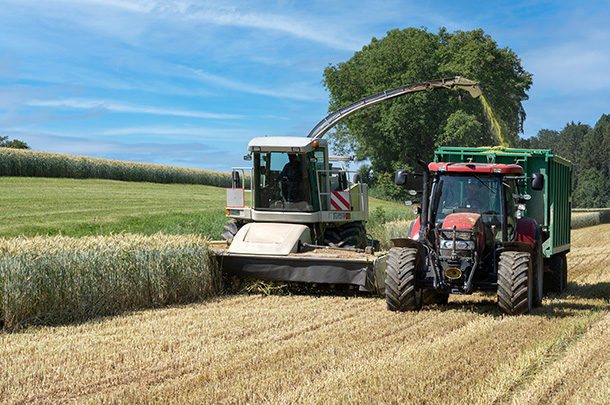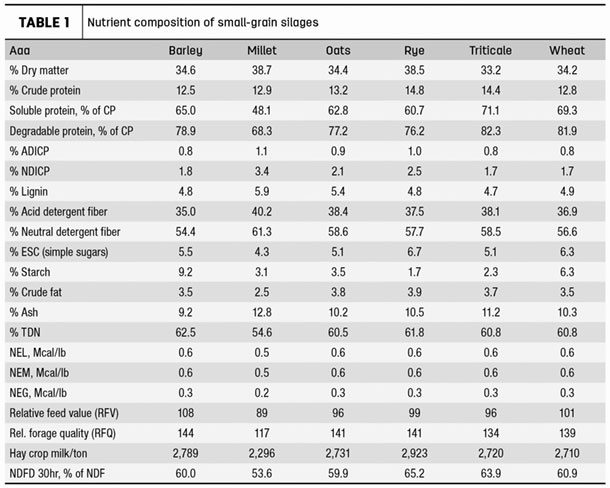Under these circumstances, cover crops, usually small grains, are becoming increasingly popular both as a protective cover for the soil and as feed for livestock. This practice allows for either grazing in the spring or storage for deferred use both as hay and silage.
In this short article, we will discuss the most common crops used for silage, as well as how their nutrient content impacts both their preservation and livestock performance. The dataset comes from approximately 500 to 10,000 samples (depending on the crop) analyzed across 15 seasons by the Dairy One Laboratory of New York. Bear in mind, these figures are averages of high and low values, and to predict their potential for preservation and/or livestock performance, it is always advisable to analyze samples.
Dry matter
Most silages in this dataset showed dry matter (DM) values that ranged between 33% and almost 39%. From this point of view, the values are mostly adequate to be preserved as silage. Only two silages showed DM concentrations slightly higher than ideal – millet (38.7%) and rye (38.5%); the use of silage inoculants might be advisable in both cases.
Nitrogen fractions
Barley, wheat, oats and millet showed values of crude protein (CP) ranging between 12% and 13%. This protein concentration is better for diets of cows particularly in the first two-thirds of their pregnancy and up to eight months pregnant. It is not that they cannot be used for the last month of pregnancy, but they will require additional supplementation with a protein/energy concentrate to meet cow requirements. These silages could very well be used to overwinter cows on the range. Rye and triticale silages can be used in these same animal categories, but in addition will also work well in late pregnancy and early lactation. They can also be used as the main forage in cow-calf operations and heifer growers, and even in limited amounts to provide effective fiber in lactating dairy cow rations.
When looking at soluble protein, the first thing to notice is the relatively low value of the millet silage (48.1%), which coincides with a lower degradable protein concentration (68.3%). Not only had this silage one of the lowest CP concentrations, but it is also less soluble and degradable. To better digest millet silage in the rumen, cows will need supplementation with a degradable protein source as well as some energy. It could either be a non-protein nitrogen source, such as urea, or a plant protein, such as distillers grains cubes. Although the protein of the latter has lower degradability compared to other feeds, there is still enough total CP to account for this deficit, and in addition, cows and heifers will benefit from the bypass protein it supplies. The greatest protein solubility and degradability are in triticale (71.1% and 82.3%, respectively) and wheat (69.3% and 81.9%, respectively). In both instances, supplementation with some grain (2-6 pounds) will greatly improve their utilization.
The crude protein fraction recovered in neutral detergent (NDICP) and acid detergent (ADICP) is indicative of heating if their value exceeds roughly 7%. It was very low overall with the highest, again for millet, at 3.4% NDICP. None of the values observed are indicative of heating, which suggests there was no damage to the protein or carbohydrates through the Maillard reaction.
Click here or on the image above to view it at full size in a new window.
Carbohydrates
Of this fraction, we will discuss the fibers – measured as neutral detergent (NDF) and acid detergent (ADF) – as well as starch and simple sugars. The NDF fraction is associated with both intake and digestibility of forages; the higher its concentration, the more its filling effect will restrict the amount the animal can eat of that forage. Millet showed the highest NDF at 61.3% (wheat straw has 73%), with all the other silages being in the mid- to high 50s. Millet also showed the highest ADF (40.2%), with triticale and oats close behind; the rest of the silages had similar values that went from the mid- to upper 30s.
Analyses of the fiber fractions clearly showed millet at a disadvantage from a nutritional standpoint, compared to the rest. All silages had hemicellulose content (NDF-ADF) in the twenties. It is important, however, not to just look at the concentration of NDF but also its digestibility (NDFD). Its digestibility at 30 hours showed rye silage as having its highest value at almost 65%, followed by triticale at 64% and wheat at 61%. This is interesting since triticale is a hybrid of wheat and rye. The NDFD of the rest was at 60%, except for millet at 53.6%.
Lignin is usually addressed together with fibrous carbohydrates because of its close association with them. All silages had close to 5% lignin, with only two slightly exceeding it: oats (5.4%) and millet (5.9%). Keep in mind that lignin is negatively associated with digestibility, which reinforces the recommendation above of not to include millet silage in animal categories with higher nutrient requirements.
Well-fermented silages show very low values of ethanol-soluble carbohydrates (simple sugars), since they are used up during fermentation. Corn silage, for example, has on average approximately 2.1%. For cover-crop silages, the values were between 5% and almost 7%, except for millet at 4.3%. If we compared them with corn silage, it is clear there is still room for utilization of this fraction to enhance silage fermentation. One could argue that the digestibility of plant cell walls in these species could hinder their utilization during the ensiling process. It is likely then that any steps taking to improve it (e.g., chopping, additives) could result in improved fermentation in the silo.
Energy and potential livestock performance
We compared relative feed value (RFV), relative feed quality (RFQ), total digestible nutrients (TDN), net energy (NE) and milk per ton of these small-grain silages. As would be expected, these energy measurements should be relatively correlated with their nutrient content. The highest RFV was for barley silage (108) followed by wheat silage (101), with the other silages in the mid- to high 90s; millet had the lowest at 89. RFQ followed a similar trend with the highest for barley (144) and the lowest for millet (117). Calculations of NE showed all silages had the same NE for lactation and maintenance at 0.6 megacalories (Mcal) per pound, except for millet which showed 17% less energy at 0.5 Mcal per pound for both. Calculations of NE for gain showed the same value for all silages at 0.3 Mcal per pound, except millet at 0.2 Mcal per pound. Potential for milk production in pounds per ton of silage showed the highest value for rye at 2,923, followed by barley 2,789. The lowest value was again for millet silage at 2,296 pounds of milk per ton of silage.
Results show that of all silages evaluated, millet was consistently poorer as a livestock feed and contained more fiber and had lower digestibility compared to the rest. There were no differences in the estimated values for net energy lactation (NEL), maintenance (NEM) and gain (NEG) across the other silages, with the exception of millet, which was consistently lower. Barley silage showed the greatest TDN, RFV and RFQ concentrations. However, when milk per ton was calculated, rye showed a potential of 134 more pounds of milk per ton compared to barley.
There might be merit in selecting a companion crop for silage depending on livestock species to feed. Data reported here suggest that barley silage is an excellent alternative across the board for pregnant ruminants, particularly during their earlier stages. Triticale and rye silages, however, seem to fit these latter categories and also growing ruminants and those in their later stages of gestation, both dairy and beef. If small-grain silage is going to be used to add effective fiber to lactating dairy cow rations, rye, barley, triticale and wheat (in that order) seem to be better choices, as they would not dilute as much of the energy in the diet. ![]()
Getty Images.

-
Alvaro Garcia
- Livestock Nutritionist
- Dellait – Dairy Nutrition & Management
- Email Alvaro Garcia












